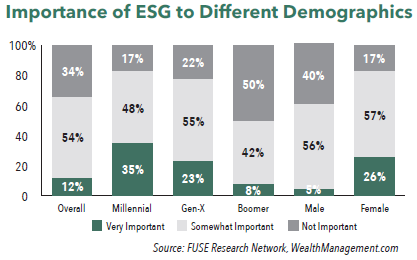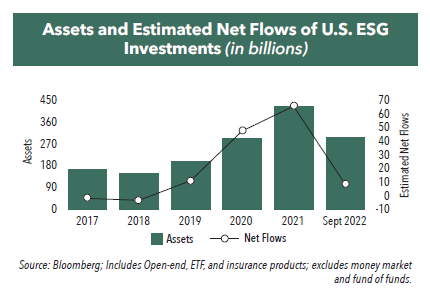Aligning Investors' Values through ESG Investing
With the increased demand and proliferation of Environmental, Social and Governance (ESG) investments, we believe it is important to evaluate investment choices and participate in a growing trend where Financial Advisors can align investments and values for their clients.
-
 Bill DavisPortfolio Manager
Bill DavisPortfolio Manager -
 Kyle BalkissoonPortfolio Manager
Kyle BalkissoonPortfolio Manager
Information about the Hennessy Stance ESG ETF (the “Fund”), a semi-transparent actively managed exchange-traded fund ("ETF") with a Portfolio Reference Basket structure:
The Fund is different from traditional ETFs. Traditional ETFs tell the public what assets they hold each day. The Fund will not. This may create additional risks for your investment. For example:
- You may have to pay more money to trade the Fund’s shares. The Fund will provide less information to traders, who tend to charge more for trades when they have less information.
- The price you pay to buy Fund shares on an exchange may not match the value of the fund’s portfolio. The same is true when you sell shares. These price differences may be greater for the Fund compared to other ETFs because it provides less information to traders.
- These additional risks may be even greater in bad or uncertain market conditions.
- The Fund will publish on its website each day a “Portfolio Reference Basket” designed to help trading in shares of the Fund. While the Portfolio Reference Basket includes all the names of the Fund’s holdings, it is not the Fund’s actual portfolio.
The differences between the Fund and other ETFs may also have advantages. By keeping certain information about the Fund portfolio secret, the Fund may face less risk that other traders can predict or copy its investment strategy. This may improve the Fund’s performance. If other traders are able to copy or predict the Fund’s investment strategy, however, this may hurt the Fund’s performance.
For additional information regarding the unique attributes and risks of the Fund, see the Prospectus and SAI.
Key Takeaways
» A growing number of investors show a pronounced interest for ESG investing, with Millennials representing the best opportunity among generations.
» Educating older investors is important given the great wealth transfer.
» Global ESG assets may surpass $50 trillion in 2025—a 40-plus percentage increase since 2020.
» Values-aligned investing combines a systematic, fundamental research process with companies that resonate with an investor’s ideals.
Growth of ESG Adoption – Millennials Lead the Pack
Significant investor groups that represent future growth show a pronounced interest for ESG investing, which today’s Financial Advisors cannot ignore. Millennial investors present the best opportunity for growth of ESG adoption. By gender, females express the strongest interest in the topic. Female decision-makers are an influential and growing segment across generational groups, and their interest in ESG-related topics provides a clear opportunity for engagement.
Importance of ESG to Different Demographics

Older investors, who possess the highest percentage of wealth, show marginal interest in the topic. These older cohorts tend to have a greater focus on protecting assets as they approach or enter the decumulation phase of their investing arc. Though these issues appear to dilute the potential of ESG among older investors, it is possible that ESG investing may provide at least a foundation to solve for these circumstances.
Educating older investors is important given the great wealth transfer that is underway. An estimated $30+ trillion in assets will shift from the older generation to Generation X and Millennials, who are more inclined to consider ESG. As noted, females are a growing segment of decision-makers, and based on longevity data this is likely to intensify, as the life expectancy of American women is five years longer than men. Assets will likely transfer to women prior to passing on to the younger generations.
ESG Market Overview: Assets and Net Flows
In January 2022, Bloomberg Intelligence posited that global ESG assets may surpass $50 trillion in 2025, which would reflect a 40-plus percentage increase in assets since 2020. The U.S. intermediary market, reflected in mutual fund and ETF assets, has experienced growth in ESG though at lower rates. While recent headlines and market volatility have tempered flows and enthusiasm regarding the topic of ESG/Sustainability, the long-term prospects and trends clearly provide tailwinds for continued growth.

Where to Invest: The Value in Values-Aligned Investing
Values-aligned investing combines a systematic, fundamental research process with companies that resonate with an investor’s ideals. This approach presents an opportunity to individualize the investment approach in an environment where personalization is being increasingly sought after. In fact, 37% of Advisors believe it is critical or very important to be able to customize solutions to their clients’ ESG preferences, according to a FUSE Research/ WealthManagement.com survey of Advisors.
Importantly, this approach to investing does not supplant the traditional, in-depth investment process applied by active managers; rather, it complements the process with additional elements of criteria and considerations when researching potential companies and constructing portfolios.
Successful application of values-aligned investing requires not only a proven, repeatable research process for sector and security evaluation, but also an integrated method for understanding and analyzing the values-oriented issues and how they may impact or enhance portfolio construction. Simple exclusionary screens, in our view, do not provide for the type of investing being discussed. While some industries may be avoided completely, the application of this approach occurs at the individual security level. This ensures that all opportunities are explored, and then only those that fit the appropriate profile are selected. This process helps to adhere to principals while also focusing on returns.
Risk mitigation is a topic of importance to most investors, regardless of age and wealth. While strong ESG adherence may be an indicator of a less risky investment, a portfolio optimization process to reduce risk is optimal to protect assets for all investors.
Opportunities to Participate
The Hennessy Stance ESG ETF provides an opportunity to invest in an actively managed strategy, utilizing a rules-based methodology, proprietary artificial intelligence (AI) model and portfolio optimization in an effort to minimize risk and maximize diversification.
- In this article:
- Hennessy Sustainable ETF
